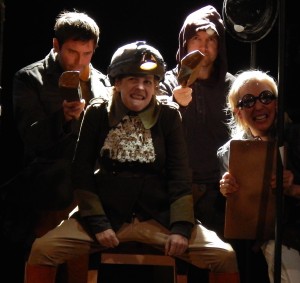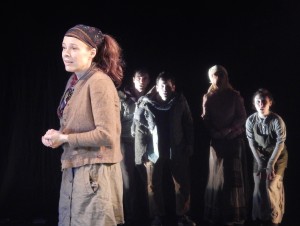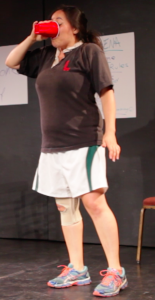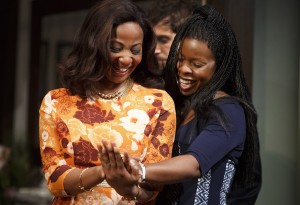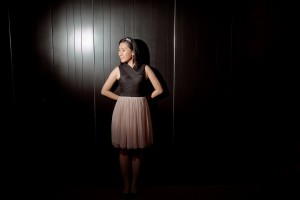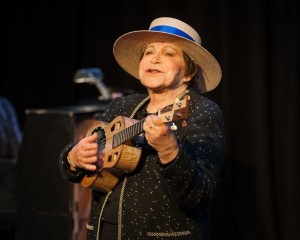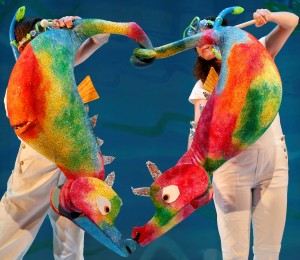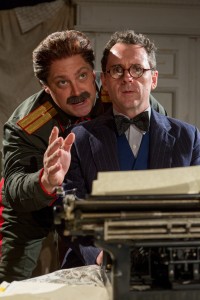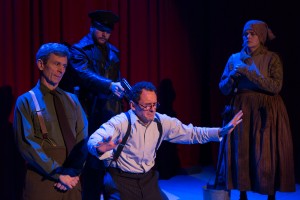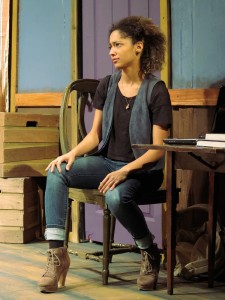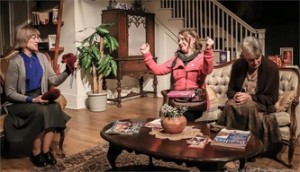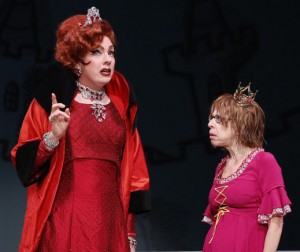Light, A Dark Comedy is a clever and smartly written play wrapped neatly with an amazing array of costumes, puppetry, lighting and media. It delivers a futuristic world ruled by an evil mayor and her equally evil, if somewhat “pretentious mystical nitwit,” sister. Sunlight has been literally sucked from the sky and leaving everyone to "stay online" or fall into darkness. No one really remembers actually seeing the sun, however, there are references and ditties scattered throughout the play that alludes to the sun. So much so that the words "day" and "light" have been replaced with the word "dim." What happens to the human spirit when subjugated by darkness and despair? And, for a young girl–what will she resort to for extra rations for her and her mother?
While pulling from modern mythology, movies and history, Light, A Dark Comedy is rich with symbolism making for an ominous, expressive tale for a modern age by playwright Greg Steinbruner. The story follows a young girl called Moth on a journey through her own darkness, from completely believing the evil Mayor to eventually confronting the truth and the Sandman. Along the way, Moth, played by Tami Stronach, encounters the Sleeper Services, who take away those who have fallen asleep. Moth also comes across the evil Mushanto Mushroom Corporation–where orphans are conscripted to work off their debt to pay for the care of the sleepers, The Underground–a rag tag group making up the resistance movement, the Queen–whose whispers cause people to sleep so that she can control their dreams, and finally Sunny and Ray–who broadcast an illegal radio show with supposedly cryptic messages for The Underground. The story languishes in the middle and it might be a tough sell for children due to the length and heavy subject matter. However, the detail in the story woven by Steinbruner and the tightly choreographed production is incredibly engaging.
Light, A Dark Comedy is brought to life by a great cast who, with the exception of Stronach, play multiple roles while creating and re-creating the stage for each scene. Here, darkness and shadows allow for characters to blend in while holding up a screen to complete the set or make a large flock of birds swirl overhead. Stronach, similar to Judy Garland in the Wizard of Oz, is the thread throughout this 90-minute journey and is rarely off stage. She, as well as the entire cast, is completely immersed in her character, movement and the story. Everything is so tightly intertwined to bring anything less to the stage could easily be catastrophic. Carine Montbertand plays the evil Mayor with great aplomb delivering a wicked, sinister character. It is her portrayal of the Mayor’s sister, The Queen, though, that appears forced. It is almost as if she is trying too hard to make her character uniquely different than the Mayor. Steinbruner's play challenges six actors, including himself, to play 16 roles in one production. With the extraordinary direction of Adrienne Kapstein the cast utilizes every opportunity to nuance 16 characters to life. From language and dialect to physical attributes and an abundance of costuming this is a challenging play both physically and mentally, and the cast made it appear seamless under her guidance. It is quite surprising when only seven actors appear on stage at curtain call.
Before all of this could take place, a talented development team created a very complex and moving production. Barbara Samuels delivers unique lighting to a relatively sunless play, Theresa Squire layers costumes for 16 characters to change into quickly, Mark Van Hare designs subtle sounds and striking music, Tom Lee designs vivid projection imagery, and Lake Simmons' delightful puppetry includes an expressive chicken laying an egg and a giant dragonfly who buzzes about the characters. Tying the vivid production together is Deb O with a steampunk style set design that utilizes three rolling “stages” and holds a multitude of props to create scene upon scene.
Light, A Dark Comedy is an unexpected 90 minutes that touches each of the five senses and is an invitation to explore the sixth. As Moth describes, “It’s on the tip of your tongue, but the name of the thing–the thing that’s missing–just doesn’t come to your lips.” It’s when Moth ventures out into the world and she comes to the crossroad of curiosity and dreaming, that she understands that only light can overcome darkness.
Light, A Dark Comedy runs until April 10 at the Triskelion Arts Muriel Schulman Theater (106 Calyer St. between Clifford Pl. and Banker St.) in Brooklyn. Evening performances are March 25 at 7:30 p.m. and matinee performances are Saturday and Sunday at 10:30 a.m. Tickets cost $18.00. To purchase tickets, visit papercanoecompany.com.






